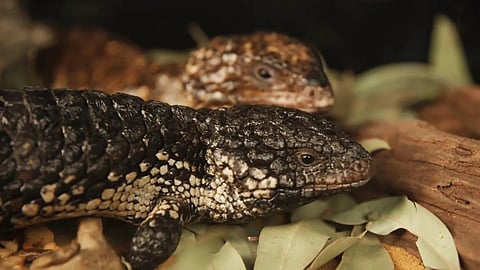

NEW YORK: Ned and Sunny stretch out together on the warm sand. He rests his head on her back, and every so often he might give her an affectionate nudge with his nose.
They’re quiet and, like many long-term couples, they seem perfectly content just to be in each other’s presence. The couple are monogamous, which is quite rare in the animal kingdom.
But Sunny and Ned are a bit scalier that your typical lifelong mates — they are shingleback lizards that live at Melbourne Museum in Australia.
In the wild, shinglebacks regularly form long-term bonds, returning to the same partner during mating season year after year. One lizard couple in a long-term study had been pairing up for 27 years and were still going strong when the study ended.
In this way, the reptiles are more like some of the animal kingdom’s most famous long-term couplers, such as albatrosses, prairie voles and owl monkeys, and they confound expectations many people have about the personalities of lizards.
“There’s more socially going on with reptiles than we give them credit for,” said Sean Doody, a conservation biologist at the University of South Florida.
Social behavior in reptiles has been largely overlooked for decades, but a handful of dedicated scientists have begun unravelling reptiles’ cryptic social structures.
With the help of camera traps and genetic testing, scientists have discovered reptiles living in family groups, caring for their young and communicating with each other in covert ways. And they aren’t only doing this because they love lizards.
Currently, 1 in 5 reptile species are threatened with extinction; researchers say learning more about reptile sociality could be crucial for conservation.
Humans have a long history of animosity toward reptiles, and influential 20th-century scientists added to the idea of reptiles as cold, unintelligent beasts.
In the mid-1900s, Paul MacLean, a neuroscientist at Yale and then the National Institute of Mental Health, began developing the triune brain hypothesis. He theorised that the human brain contained three parts: the reptilian R-complex, which governed survival and basic instinctual behaviors; the paleomammalian complex, which controlled emotional behavior; and the neomammalian cortex, which was responsible for higher functions such as problem-solving and language.
MacLean’s ideas were popularised in Carl Sagan’s “The Dragons of Eden” in 1977, and they are deeply rooted — the idea of the “lizard brain” as a center for basic survival instincts is still widely believed, even though it is not based on actual facts.
“It’s pretty much totally bogus,” said Stephanie Campos, a neuroethologist at Villanova University.
Gordon Burghardt, an ethologist at the University of Tennessee, Knoxville, who has studied animal behavior for more than 50 years, said that many scientists, even herpetologists, were blinded by their biases, believing that social behaviors “can’t occur in these animals, therefore you’re not seeing what you’re seeing.” Even without our cultural biases, reptiles can be difficult to study.
“A lot of them are pretty shy,” said Allison Alberts, a conservation scientist and co-founder of the Iguana Specialist Group at the International Union for Conservation of Nature.
She added that “They’re so sensitive to when a person’s there. They just freeze — they will not do some of their normal social interactions when a person’s around.” Many forms of interaction between reptiles are also invisible.
Visit news.dtnext.in to explore our interactive epaper!
Download the DT Next app for more exciting features!
Click here for iOS
Click here for Android